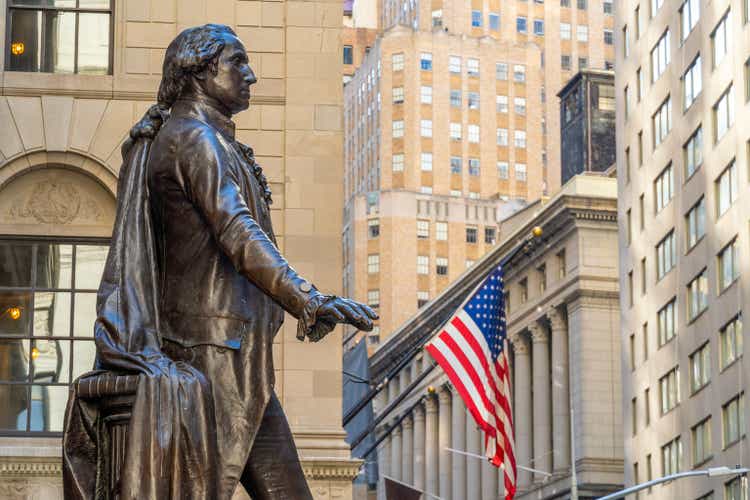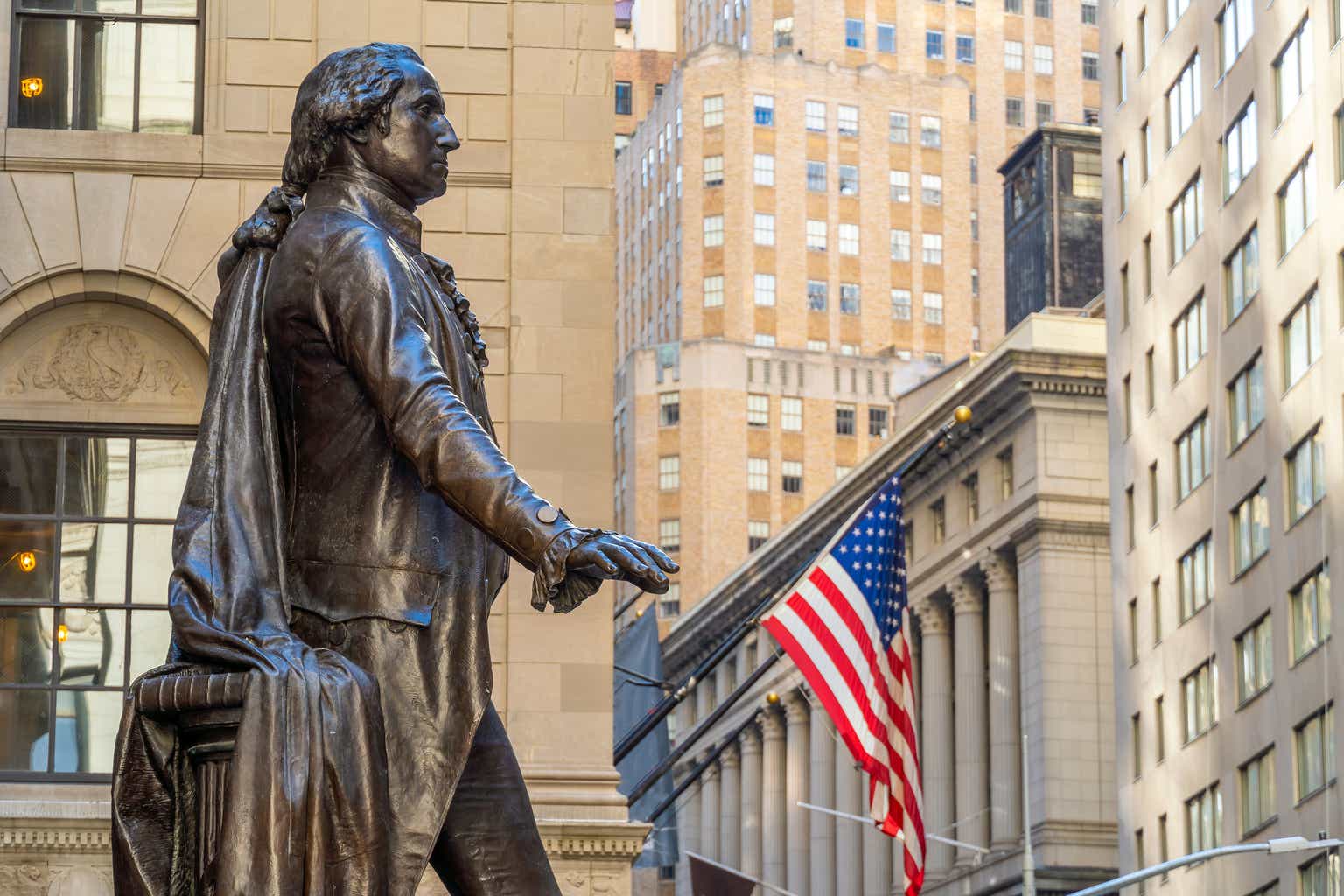f11photo/iStock via Getty Images
Listen below or on the go on Apple Podcasts and Spotify
The Nasdaq and S&P gained led by big names in shortened session. (0:17) FOMC minutes show Fed members wanting more data before rate move. (3:48) Jeff Bezos sells $5 billion in Amazon stock. (5:04)
The following is an abridged transcript:
Welcome to a special pre-holiday edition on Wall Street Lunch.
The markets closed early ahead of the Fourth of July with a broader market rally led by growth stocks.
The Nasdaq (COMP.IND) rose 0.9% and the S&P 500 (SP500) rose 0.5%, both hitting new highs. The Dow (DJI) fell less than 0.1%, dragged down by a price decline in UnitedHealth.
Seven of the 11 S&P sectors closed higher, with Into Tech (XLK) at the top. Nvidia (NVDA) did lots of the heavy lifting, rising 4.5%. Tesla (TSLA) also lent a hand, up 6.6% and finishing higher for its seventh-consecutive session.
While many people were already getting a jump on the festivities, there was no rest for those providing economic data (both from the public and private sectors) as a raft of reports hit before, during and even after market hours.
Cutting to the chase, none of the indicators jolted the current market narrative that while the labor market is still tight, inflation may cool enough for rate cuts in September.
Jobs numbers dominated the premarket numbers.
ADP said June private payrolls rose by 150,000, below the consensus of 167,000. The official June jobs figures hit Friday with private payrolls expected to rise by 160,000, with overall nonfarm payrolls rising by 189,000.
Weekly jobless claims rebounded after two weeks of declines. Claims rose to 238,000 from an upwardly revised 234,00 and were ahead of expectations of 233,000.
And Challenger’s measure of June layoffs fell 24% from May, but were still 20% above the year-ago level and the highest June number since 2009 (excluding the pandemic).
Pantheon Macro economist Ian Shepherdson says: “Layoffs are still trending higher, but the data will be noisy over the coming weeks.
Initial claims “usually are choppy in July as a result of the timing of auto plant shutdowns, which vary every year. Nevertheless, most leading indicators suggest that claims will continue to trend up.”
On ADP, “it has been more accurate simply to assume that last month’s initial print will be repeated than to take ADP’s estimate at face value,” he warned. “On this occasion, however, we think the deceleration signaled by ADP’s data makes sense, given the pick-up in layoffs and recent deterioration of hiring indicators.”
Also this morning, May Factory Orders unexpectedly fell -0.5% vs. +0.2% consensus and a downwardly revised +0.4% in April.
And the Institute of Supply Management said its services index fell back into contraction territory, down to 48.8 in June from 53.8 in May and well shy of the 53 consensus. Treasury yields fell after the ISM, with the 10-year (US10Y) back down to 4.35%.
Wells Fargo economists said: “The mood music is changing, but we expect the overall ISM overstates current weakness. The select respondent comments in the release struck a tone of caution and generally mentioned slower or softer activity relative to a month or year ago, but there is little indication the tide is turning fast.”
“Ultimately, an optimist looks at this release and sees much of what the Fed is fighting for,” they added. “Service-sector activity is cooling and giving way to a moderating labor market and ultimately softer price pressure.”
After the bell, the FOMC released the minutes from its last meeting, with members noting a need for more data to change policy.
Fed officials at the June meeting “emphasized that they did not expect that it would be appropriate to lower the target range for the federal funds rate until additional information had emerged to give them greater confidence that inflation” is on its way to the target of 2%.
Some officials stressed a need for patience for high rates to tighten monetary policy, but others did not write off a rate hike if inflation stays elevated.
According to the minutes: “Several participants specifically emphasized that with the labor market normalizing, a further weakening of demand may now generate a larger unemployment response than in the recent past when lower demand for labor was felt relatively more through fewer job openings.”
Among active stocks today, a Paramount Global (PARA) deal with Skydance Media is expected to be completed by the weekend. CNBC says transaction to purchase Paramount controlling holder National Amusements and merge it with Paramount could happen as soon as Friday
The terms of the revised deal are largely the same as the deal that was scuttled last month, except that there will now be $100 million for National Amusements and $100 million for indemnification. Paramount controlling holder Shari Redstone will receive $1.75 billion for National Amusements.
Amazon (AMZN) Executive Chairman Jeff Bezos sold 25 million company shares for $4.93 billion, according to an SEC filing. He cashed in for an average of $197.20 per share. Bezos has now earned about $7 billion from selling Amazon shares year to date after selling 12 million shares in February for more than $2 billion. His plan allows him to sell up to 50 million shares by the end of January.
Constellation Brands (STZ) posted mixed results for its fiscal first quarter. Revenue rose 6% year-over-year to $2.66 billion. Comparable EPS of $3.57 was above the $3.45 consensus and $3.04 a year ago.
Looking ahead, Constellation Brands sees FY25 EPS of $13.50 to $13.80 vs. the consensus estimate of $13.65. The company expects operating cash flow of $2.8 billion to $3.0 billion, vs. $3.1 billion consensus.
The board of directors at Southwest Airlines (LUV) announced the adoption of a limited-duration shareholder rights plan as it looks to play defense against activist Elliott Investment Management. The rights plan will be triggered if an entity holds a 12.5% economic interest in the company. In addition, the company highlighted that the rights plan is effective immediately and will expire in one year.
Elliott announced it had accumulated an economic interest in Southwest of about 11%. But it was noted that Elliott has not reported its full purported position in Southwest Airlines on any filings with the SEC and has made regulatory filings with U.S. antitrust authorities that would provide it the flexibility to acquire a significantly greater percentage of Southwest’s voting power across two of its funds starting as early as July 11.
In other news of note, the odds of President Joe Biden getting the Democratic Party nomination have plunged, with Vice President Kamala Harris’ chances of facing former President Donald Trump jumping sharply.
The odds of Biden being the nominee are now at 41%, down from around 70% early Monday, according to Bloomberg (using odds from PredictIt). Harris has jumped from below 15% to 39%.
Biden’s debate performance last Thursday led to calls for him to retire from the race. But the odds of him being the nominee didn’t really start to sink significantly until late Monday. Across the pond, the U.K. Conservative party has been embroiled in a scandal on bets placed that correctly predicted the date of the general election to be held on July 4.
And in the Wall Street Research Corner, well-known J.P. Morgan strategist Marko Kolanovic is hanging up his spikes.
Kolanovic, who gained a media following and notoriety for having a PhD. in theoretical physics, has struggled with broad U.S. equity market calls over the past couple years.
Citing an internal memo, Bloomberg reports that Kolanovic is leaving his position as chief global market strategist at JPM to explore other opportunities. The memo says Hussein Malik will now be sole head of global research, a position he had been sharing with Kolanovic.
Kolanovic was consistently bullish on U.S. equities for much of 2022, a year in which the benchmark S&P 500 slumped nearly 20%. He turned bearish as the market bottomed and has remained firmly so even as the S&P rebounded almost 25% in 2023 and advanced more than 14% in H1 2024. As recently as Friday, Kolanovic backed his ultra-bearish year-end target of 4,200 points for the S&P.

